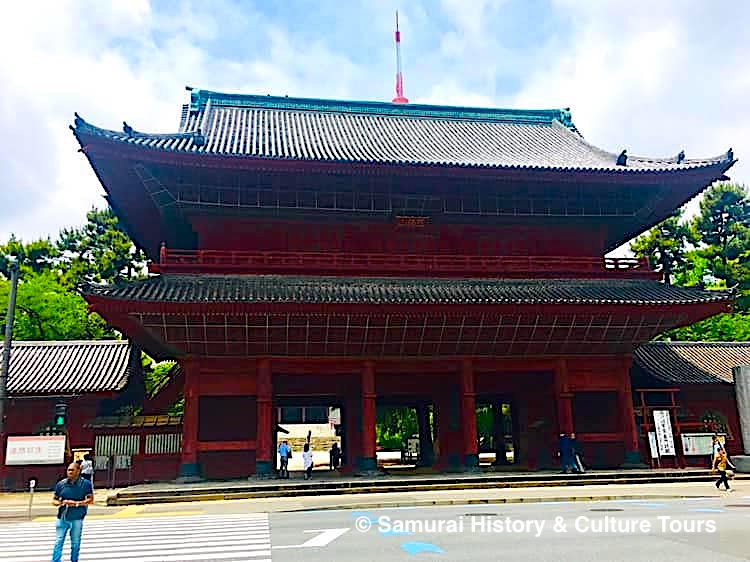Stories
Historical Zojo-ji Temple, and the Graves of the Tokugawa Shogun

Discover Old Edo in Modern Tokyo, and the Mausoleums of the Tokugawa Shogun
The Zojo-ji Temple in Tokyo’s Minato-ku, and close to the Tokyo Tower, was founded in 1393 as a seminary for Jodo Shu sect Buddhism in the east Japan Kanto region. During the Edo Period it was the Tokugawa clan family temple. At its peak, there were 120 structures standing and over 3,000 Buddhist monks in attendance. Most of the temple was destroyed in WWII bombings, however the main gate, the Sangedatsu-mon dating from 1622 remains. Behind the main prayer hall are the remaining graves of six of the 15 Edo Shogun.
The temple was relocated to it current site in 1598. Shortly after Tokugawa Ieyasu took control of Edo, when the Zojo-ji was chosen as the bodai-ji or family temple of the Tokugawa, and a magnificent main hall was constructed. The Zojo-ji also served as an administrative center to govern the religious studies and activities of Jodo shu.
Its’ precincts covered an area of 826,000 square meters and contained 48 smaller attached temples and about 150 schools, with around 3,000 priests and training novices resided.
Tokyo’s Oldest Wooden Structures
Zojo-ji Temple’s current main gate, the 21 meter high Sanmon was originally the inner gate. Formally known as the Sangedatsumon, the bright vermillion lacquered exterior was one of Edo’s most famous landmarks, and is one of Tokyo’s oldest remaining wooden structures, built in 1622 by the Shogunate’s chief carpenters, the Nakai clan, who were also responsible for the building of Nagoya Castle’s keep. The Sanmon is the Zojo-ji’s only remaining original temple building and is an Important Cultural Property. The actual main gate can be seen further behind it. According to Jodo Pure Land Buddhism lore, passing through this gate cleanses one of the three worldly afflictions, greed, anger, and ignorance.

The gate’s second floor is closed to the public, but contains numerous Buddhist statues including two bodhisattvas and 16 of the Buddha’s dedicated disciples, all dating from the Edo period. A ten-year restoration project of the gate is scheduled to begin in April of 2025.
One of the Three Famous Bells of the Edo period, Zojo-ji’s Daibonsho, the Great Bell was dedicated in 1673 after seven repeated castings. Weighing 15 tons, the bell has a diameter of 1.76 meters, and is 3.33 meters high. The bell is still rung six times twice a day – early each morning and evening. This is done to purify Bonno, the one hundred and eight earthly passions, which lead people astray.
Features
The Kyozo Sutra Hall was constructed with the financial aid of Tokugawa Ieyasu in 1613 with octagonal-shaped revolving bookshelves inside to safe-keep the Sandaizokyo (Tripitake), the three principal Buddhist canon sutras which were donated by Ieyasu. These sutras have been designated as National Important Cultural Properties. The Kyozo Sutra Hall was remodeled and relocated in 1800. This storehouse has been designated as a Tokyo Metropolitan Government Cultural Property.
The Zojo-ji’s Daiden Hondo main Hall was rebuilt in 1974. Enshrined in this hall is a Muromachi period statue of Amida Buddha, an image of the Great Teacher Shan-tao, founder of China’s Jodo sect Buddhism, and Honen Shonin, founder of Japan’s Jodo sect. Below the Daiden main hall is the Treasures Gallery exhibition space. The gallery’s centerpiece is the highly detailed 1:10 scale model of the second shogun, Tokugawa Hidetada’s Taitokuin Mausoleum. The original mausoleum was built in 1632 by Hidetada’s son and heir, Tokugawa Iemitsu. As with many of the Zojo-ji Temple’s other structures, the mausoleum was destroyed in the WWII air raids of 1945.
The highly detailed model is 4 meters wide and 6 meters long, and features the Main and Worship Halls as joined by a connecting hall. The structure’s roof is exhibited separately to allow an unobstructed view of the interior decorations. The model was built by a team of 150 carpenters and artisans to showcase Japanese culture and technology at the Japan-British Exhibition of 1910 in London. Over eight million visitors came over the five-month long exhibition. The model was later presented to King George V and displayed at the Royal Botanic Gardens in Kew, before being dismantled and stored as part of the Royal Collection. The model was recently rediscovered and returned to the Zojo-ji on loan for public display.
Mausoleum of The Tokugawa Shogun
Tokugawa Ieyasu proclaimed the Zojo-ji as his Edo based family temple, and along with construction of Edo Castle, allocated funds to rebuild and expand the temple. Zojo-ji then came to be widely known as one of Japan’s principal Buddhist temples. Located within in the Zojo-ji’s precincts are the tombs of six of the 15 Tokugawa Shogun, the second Shogun, Hidetada, sixth Shogun Ienobu, Ietsugu (7th), Ieyoshi (12th) Iemochi (14th) also the wife of Shogun Iemochi, Imperial Princess Kazunomiya Chikako, and the wives and children of various shogun. Tokyo Tower stands on land formerly owned by the Zojo-ji, and some of the other graves of the Edo Shogun were opened, examined and relocated to make way for the tower’s construction.

Many of the other structures have since been rebuilt, and the Zojo-ji continues to serve as the headquarters of the Jodo Shu sect and the central nembutsu seminary for priests and novices. It remains one of the most famous and visually appealing grand Buddhist temples of Tokyo.


